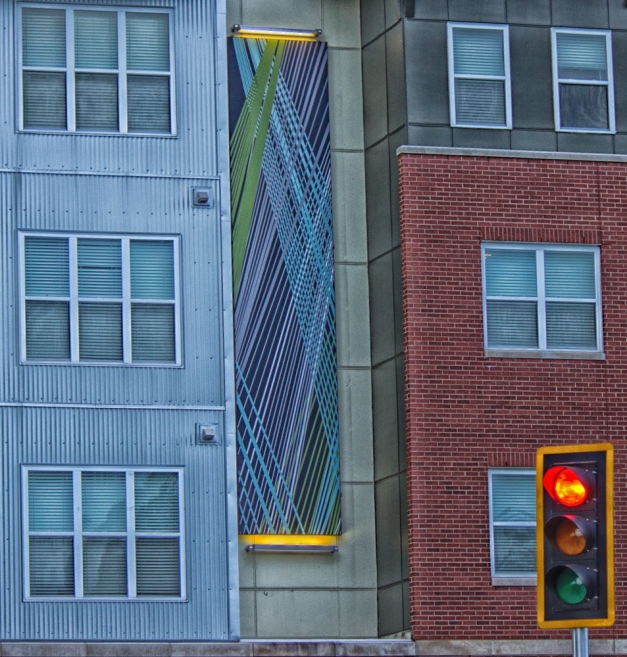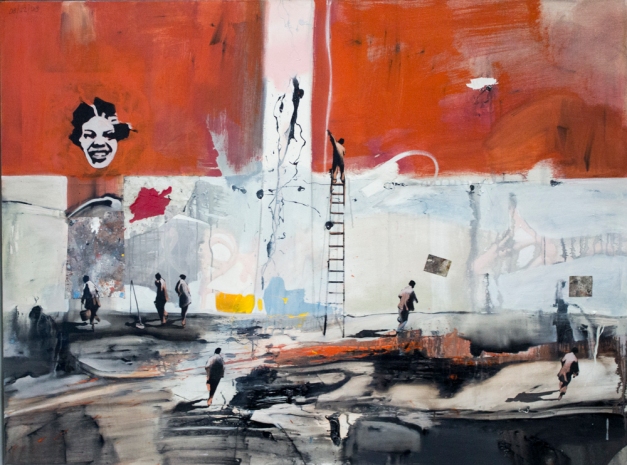
Betty Woodman
color woodcut and monotype collage
42 3/4 x 39 1/2 inches
Collection of the Kemper Museum of Contemporary Art, Kansas City, Missouri

Untitled, 1985 – 99
Paint on wood
Purvis Young
“Self – taught artist Purvis Young created work that captured life in Overtown in inner-city Miami. An interstate highway built over Overtown in the 1960s drove out many of the once – thriving area’s African American – run businesses and inhabitants. Young opted to stay, painting his vision of his community directly on the walls of abandoned buildings and the alley where he made his home. He also painted on found materials like this tabletop. A red column near its center suggests a figure, while the jumbled high-rises evoke the disorienting nature of urban life.”

Evening Lamp
Romare Bearden
Watercolor and collage on board
A major influence on art in the late 20th century, artist Romare Bearden is most famously known for his collages depicting experiences of African Americans throughout his life. In Evening Lamp (1986), he uses painting and collage to create a portrait of a woman. Bearden’s mastery of multiple skills was an inspiration for Marcus Jansen abstract expressionism, who like Bearden uses collage to connect art and social realities.

Wonder, 1994
Robert Rauschenberg
Collodion transfer and wax on canvas
Marcus Jansen was fourteen years old when he first saw an exhibition catalogue of Robert Rauschenberg’s work. Rauschenberg often incorporated found objects and collage techniques in his compositions, which developed into his signature style. This approach, Jansen has said, inspired him to continue on his path of becoming an artist. Rauschenberg said, “Painting relates to both art and life. Neither can be made. (I try to act in that gap between the two.)” This belief allowed Rauschenberg to create works that move between art and life and are in constant dialogue with the surrounding world. Jansen’s use of found objects and collage techniques to create dialogue about the world is a direct influence of Rauschenberg’s approach to art making.

Jim Dine arranges tools within his composition to create larger symbols, allowing his work to be both moderately autobiographical and open to interpretation. Untitled (2000) uses a hammer, wrench, pliers, blow torch, drill and bolt cutters which create what looks like a phoenix rising from ashes. The bolt cutters serve as its legs and the drill, handle, and blow torch as its wings. At this time in his career, Dine was creating different bird motifs. The phoenix—a symbol of rebirth—relates to themes in Marcus Jansen’s work that respond to a diagnosis of Post-Traumatic Stress Disorder (PTSD) from his time in the United States Army. He used painting as a therapeutic release and as a way to re-emerge from the challenges and suppression of PTSD.

Untitled (date unknown)
Screen print on paper
Roy Lichtenstein
Roy Lichtenstein’s Untitled (date unknown) appears similiar to works in his Modern series which focused on American architecture and design of the 1920s and 1930s. Using his signature style of comic strip-inspired Pop art, Lichtenstein shows several angles of a commercial building, possibly asking viewers to think about industrial advancements in urban areas.
![]()

The Lichtenstein print reminded me of this photograph I took in Columbus, Indiana.

“Empty Plates (2007) calls attention to the burden of people who struggle economically. Three collaged spoons spaced almost evenly in the background of the painting possibly suggests the number of people in a household. The emptiness of one sullen gray plate and its lack of any remaining crumbs reinforces a sense of scarcity. Stacked coins lining the rim of the plate suggest the household’s poverty. The equation on the right of the canvas also adds to the element of scarcity in this painting, as the question mark represents the question of whether the family has enough. Jansen has seamlessly used his mastery of brushstroke and collage techniques to create this work of art.”

Mt. Katahdin—November Afternoon (1942)
Marsden Hartley
American, 1877–1943
Oil on Masonite
After years of travel, Marsden Hartley proclaimed himself “the Painter from Maine.” This painting of Mt. Katahdin, Maine’s highest peak, belongs to a series focused on the mountain. Following a visit there in October 1939, Hartley painted multiple canvases over a three-year period. He modified his palette to suggest different seasons in each painting. In Mt. Katahdin—November Afternoon, the contrast between the blue sky, purple mountains, and auburn woods evokes an early-winter day. Hartley identified with the remote peak, seeing it as an emblem of his own lonely resilience.

Fallen Angel (1959)
Oil on canvas
Byron Browne
American (1907-1961)
“A prime example of Abstract Expressionism, Fallen Angel (1959) features a gestural scene of an abstracted angel-like figure. This work showcases his signature style of organic abstract shapes with his studies from nature. Byron Browne was a founding member of the American Abstract Artist, an association to promote and understand Abstract art. Browne and Willem de Kooning (American, 1904-1997), another founder, whose work is also featured in this exhibition, use a range of techniques, from gestural mark making to more detailed brushstrokes and figural abstraction. Jansen echoes both Browne and de Kooning’s painterly gestural strokes in the collaged squares and pavement in Streets, attesting to Jansen’s contemporary conversations with Abstract Expressionism.”

